Held at the Los Angeles County Arboretum in Arcadia, the Inter-City Cactus and Succulent Show and Sale is thought to be the largest of its kind in the world. It was started 36 years ago and held this year for the 35th time (no event in 2020 because of COVID-19). The Inter-City Show, as it's commonly called, is co-hosted by three Southern California organization: the San Gabriel Valley Cactus & Succulent Society, the Los Angeles Cactus & Succulent Society, and the Long Beach Cactus Club. The latter is the oldest cactus club in the country (founded in 1933).
According to the Los Angeles Times, the 2021 Inter-City Show attracted almost 8,000 visitors over the course of three days (August 6-8, 2021). 118 members of the three organizing clubs entered 1300 plants in the Show. They were judged by a panel of cactus and succulent experts, and the top three winners in each class and division were awarded ribbons. In addition, special rosettes were given to 24 outstanding entries, based on the judges' preferences.
The photos in this post are of the plants that caught my eye. Many did win awards, but others didn't. In spite of objective criteria, judging is subjective, and there were several instances where I disagreed with the judges' decision. In the end, we can all agree that everybody has different likes.
A technical note about these photos: The lighting inside the hall was tricky. Light levels were wildly uneven but generally on the low side. This resulted in images with low contrast and visible grain. I tweaked my photos as well as I could, but the quality isn't always as good as I would have liked. Next time I'll bring a flash.
Cue up “Pictures at an Exhibition” by Modest Mussorgsky. I prefer Maurice Ravel's arrangement for full symphony orchestra.
 |
This photo shows about two thirds of the show plants
|
 |
| Typical table |
The first group of plants I went looking for were agaves (duh!). There were only about a dozen entries, so about 1% of the total plants entered. Initially, I was disappointed, but then I realized that many agaves simply grow too big to be displayed at a show.
 |
| Agave albopilosa (Mexico) |
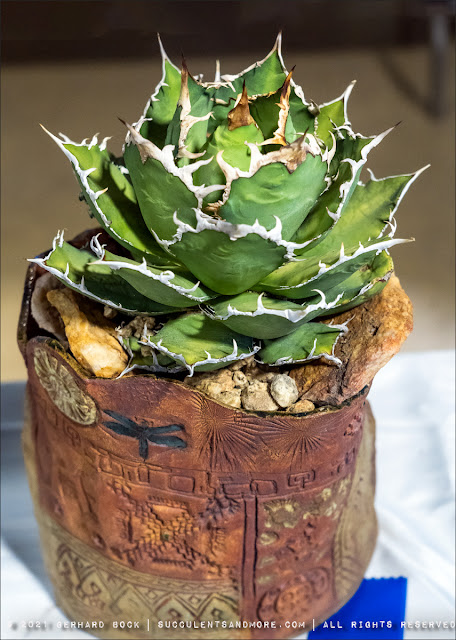 |
| Agave oteroi (Mexico) |
 |
| Variegated ×Mangave 'Bloodspot', a real stunner |
 |
| This variegated Agave utahensis var. nevadensis (California, Nevada) was my favorite entry in the Agave category. |
 |
| I'd never seen a variegated Agave utahensis before. Yes, it has some leaf damage, but because of its rarity, it's an extraordinary specimen. Unfortunately, all it got was an Honorable Mention. |
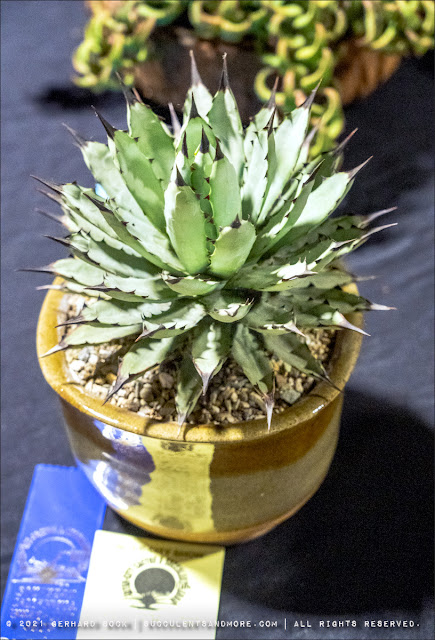 |
| This Agave macroacantha (Mexico) was the top agave in the show in the judges' opinion. Nice plant, sure, but not really that special. |
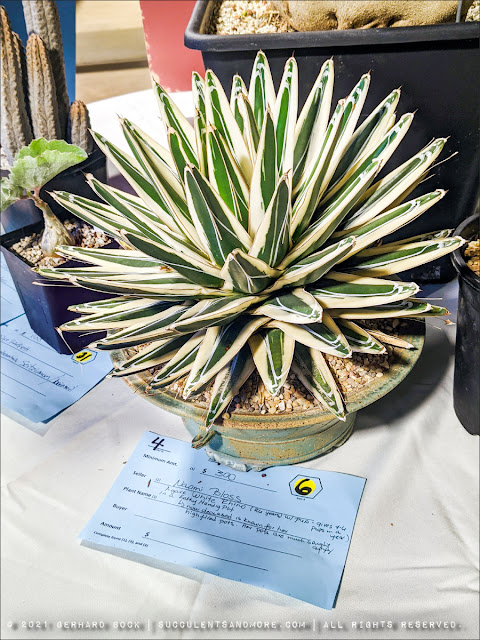 |
| This Agave victoriae-reginae 'White Rhino' was donated for the live auction on Saturday evening. Huge and flawless. It went for $500, which I think is a bargain, considering the size. |
The plants that won perpetual trophies (“Best Agave,” “Best Aloe,”, “Best Madagascar Plant,” etc.) were displayed in a special area:
 |
| Aloe castillonae (Madagascar) |
 |
| Acharagma roseanum (Mexico), best staged plant in show |
 |
| Creeping devil cactus (Stenocereus eruca) (Mexico) by Tony Marino |
 |
| Creeping devil cactus (Stenocereus eruca) (Mexico), my favorite plant of the entire show |
Cacti made up the bulk of the entries. There are 58 different classes for the Cactus section (
see official entry rules). Some are very general, like “Opuntia North American,” others oddly specific, like “Mammillaria cluster w/o hooks over 10" to 14".” I'm no cactus expert, i.e. I can't really assess a plant for its technical characteristics. Instead, I simply photographed the ones that caught my eye.
 |
| Ariocarpus retusus (Mexico) |
 |
| Leuchtenbergia principis (Mexico) |
 |
| Ferocactus gracilis (Mexico) |
 |
| Mammillaria lloydii (Mexico) |
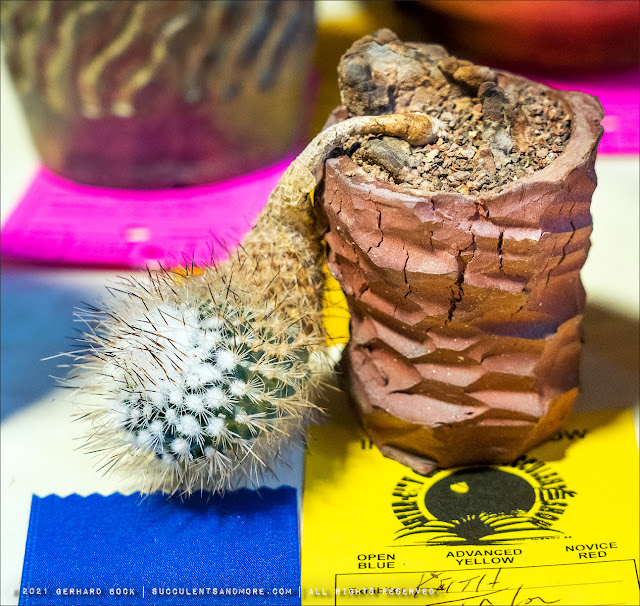 |
| Turbinicarpus booleanus (Mexico) |
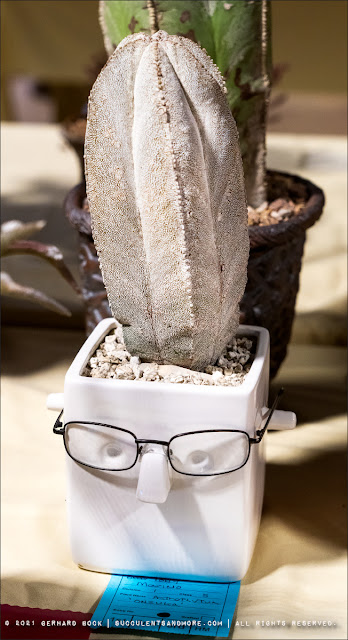 |
| Astrophytum myriostigma 'Onzuka' (Mexico, cultivar selected in Japan) |
Staging is a big aspect of show plants. The pots above are what I expect to see in a show of this caliber. But several trends are emerging. The first is pioneered by Tony Marino. He glues together smaller pieces of rock to form naturalistic containers. I realize this may not be to everyone's liking, but I love the look.
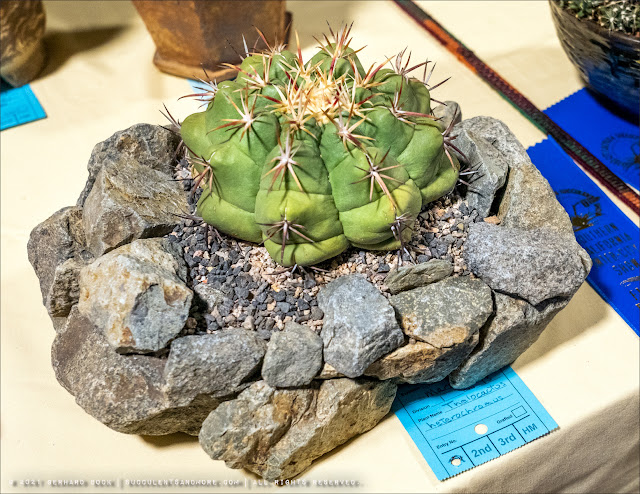 |
| Thelocactus bicolor ssp. heterochromus (Mexico) |
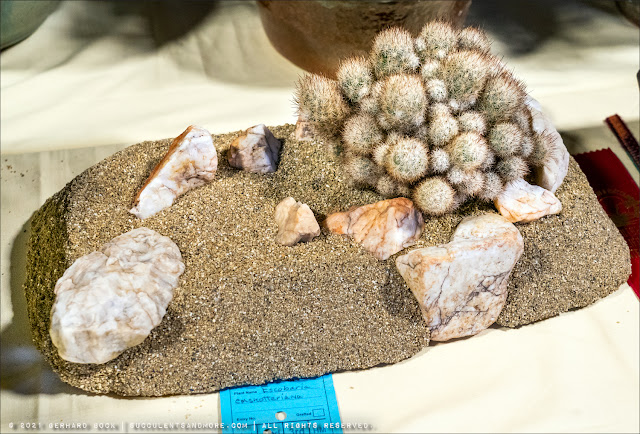 |
| Escobaria emskoetteriana (Texas, Mexico) |
 |
| Eriosyce occulta (Chile) |
 |
| Echinomastus unguispinus var. laui (Mexico) |
The second trend is a truly radical departure: a rejection of the fancy artists' pots and handmade containers in favor of plain plastic pots. When you think about it, it really is the most “democratic” material because everybody can afford it and it doesn't detract from the plant itself.
 |
| Echinocactus grusonii (Mexico) |
The golden barrel cluster above was the largest example of this trend. Maybe this wasn't the right plant choice because it did look like the whole thing came directly from the Home Depot Garden Center.
Smaller examples did score well with the judges:
 |
| Turbinicarpus jauernigii (Mexico) |
 |
| Turbinicarpus jauernigii (Mexico) |
 |
| Blossfeldia liliputana (Argentina), the smallest of all cacti |
Apparently, the intention with these small plastic pots is to represent natural conditions as closely possible. At least that's what I was told.
More small plants:
 |
| Lithops aucampiae ssp. euniceae (South Africa) |
Lithops as colorful as fruit candy:
 |
| Lithops planter by Tori Wilson |
 |
| Lithops planter by Lucas Chen |
Like the Agave category, the Aloe category felt underrepresented. Predictably, the species that are challenging to grow did the best:
 |
| Aloe florenceae (Madagascar), one of the smallest species and daunting to keep alive |
 |
| Aloe erinacea (Namibia), beautiful but easy to kill by overwatering |
More nicely staged small plants:
 |
| Haworthia collection |
 |
| Sansevieria kirkii 'Cleopatra' (Malawi, Tanzania) |
 |
| Crested Stapelia leendertziae (South Africa) |
 |
| Avonia recurvata ssp. buderiana (South Africa) |
 |
| Greenovia aurea (Canary Islands) |
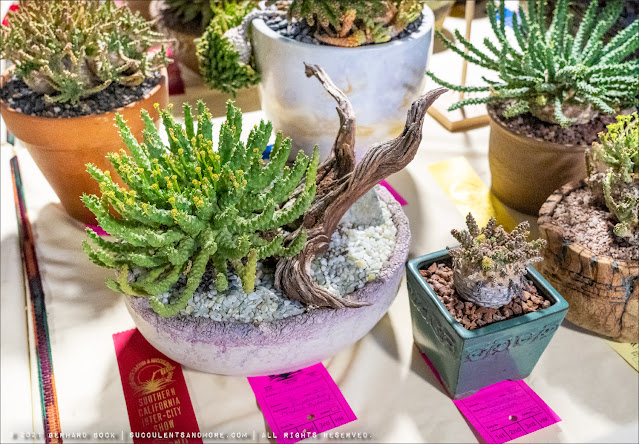 |
| Euphorbia 'Medusa hybrid' |
 |
| Euphorbia cylindrifolia ssp. tuberifera (Madagascar) |
Next to cacti, caudiciforms—or “fat plants,” as they are often called—made up the second biggest group in the show. Some of these plants are massive, requiring large and heavy containers. In some cases, a couple of people are needed for transportation.
 |
| Pachypodium horombense (Madagascar) |
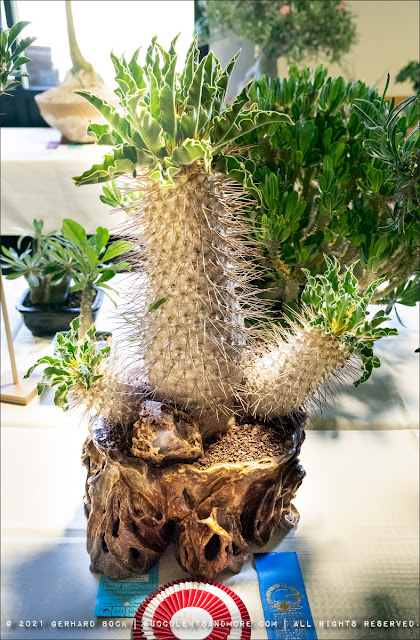 |
| Pachypodium namaquanum (South Africa, Namibia) |
 |
| It may look like haggis, but it's Pachypodium rosulatum ssp. gracilis (Madagascar) |
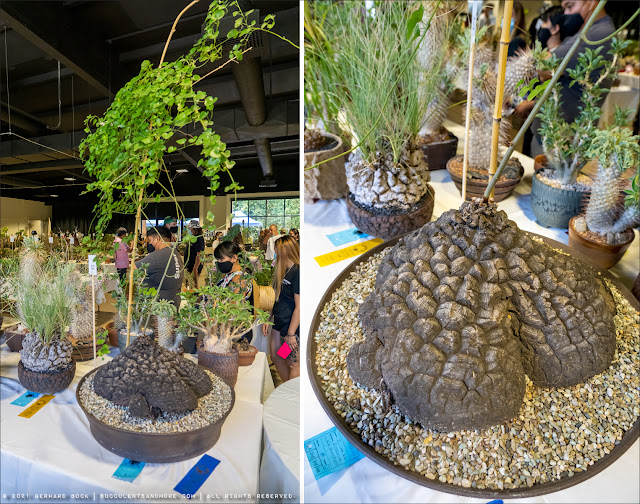 |
| Dioscorea elephantipes (South Africa) |
 |
| Calibanus hookeri (Mexico) |
 |
| Calibanus hookeri (Mexico) |
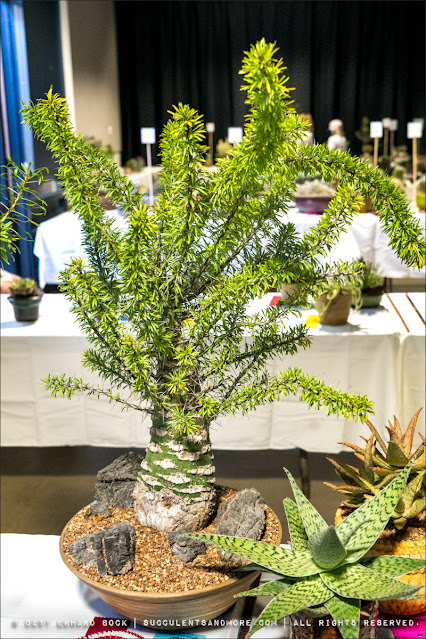 |
| Fouquieria purpusii (Mexico) |
I wasn't looking for dudleyas, not expecting any to be in the show, but I happened to come across the few that had been entered. To my delight, they were all rarely seen species.
 |
| Dudleya pachyphytum (Mexico), my very favorite dudleya species |
 |
| Dudleya edulis (California), apparently fairly common in the wild (whatever that may mean in the dudleya world) but not often seen in cultivation |
 |
| Dudleya densiflora (California), a narrow endemic limited to the San Gabriel Mountains in Los Angeles County where it's known from five locations |
As I mentioned earlier, these were my favorite plants. There were many I didn't photograph. If you want to see the top winners, watch these two YouTube videos posted by the Cactus and Succulent Society of America:
The best video about the 2021 Inter-City Show is this coproduction between Hunter of
Cactus Quest and Kevin of
Crazy4Cactus:
© Gerhard Bock, 2021. All rights reserved. No part of the materials available through www.succulentsandmore.com may be copied, photocopied, reproduced, translated or reduced to any electronic medium or machine-readable form, in whole or in part, without prior written consent of Gerhard Bock. Any other reproduction in any form without the permission of Gerhard Bock is prohibited. All materials contained on this site are protected by United States and international copyright law and may not be reproduced, distributed, transmitted, displayed, published or broadcast without the prior written permission of Gerhard Bock. If you are reading this post on a website other than www.succulentsandmore.com, please be advised that that site is using my content without my permission. Any unauthorized use will be reported.

















































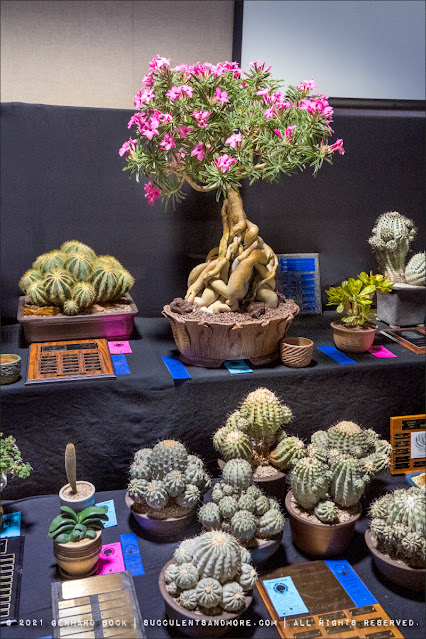





A wonderful post, read while listening to the suggested music. Very fun to see the odd and unique plants, all so lovingly cared for. I really like the natural stone creations that housed some of the plants and enjoyed the creativity of matching plants and posts, such as the Lithops "candy" planter: it's astonishing. As someone who tried (and liked) haggis, I chuckled at your comparison. Almost shed a tear seeing Sansevieria kirkii 'Cleopatra'; I really want one!
ReplyDeleteThat Sansevieria! That was one plant I seriously coveted!!
DeleteInteresting how the dead leaves are left on the greenovia. And beautiful aloe in that fouquieria shot! Plastic pots hold moisture longer which sounds a little dangerous but maybe is easily factored into care. So many beautiful plants -- that Pachypodium horombense is a standout! Thanks for covering the show, Gerhard.
ReplyDeleteI think if you removed the dead leaves on the greenovia, there wouldn't be much left, LOL.
DeleteI liked many plants in the show, but I could only envision a few of them in my garden.
While I love seeing fancy containers, I feel it's a bit of an elitist thing, seeing how not everybody can afford containers that often cost $100 or more...
I would have a hard time picking a favorite here. But the Lithops planters stick in my mind mostly because I can't imagine trying to maintain them . And the variegated 'Bloodspot' ...!
ReplyDeleteI talked to the woman who created the lithops planter. Apparently, she put the plants in the pot just prior to the show and was going to take them out again right after. So it's not a permanent arrangement.
DeleteSo interesting! I was already deep into a pot comparison when you started to point them out. I love the "glued rock" creations but just can't get behind the plastic.
ReplyDeleteI'll arm wrestle you and chavliness for that sansevieria!
Oh no, no arm wrestling for me :-D
DeleteSince you have a broken ankle, I'll let you have the sansevieria!
Loree deserves it! She's been through a lot this summer.
Deletethose caudiciforms have got to be the weirdest plants ever. Ugly but beautiful in their ugliness.
ReplyDeleteIn nature, many of them are shrubs or even trees, and the caudex is underground.
DeleteWonderful coverage of the show, thank you so much. I recognize some plants from past shows, looking even better this year. Hopefully next year I'll get to attend again.
ReplyDeleteMy Aloe erinacea is looking like it is coming back, fingers crossed--I may be the only gardener ever who didn't water hers enough--once every two years isn't enough! (Now I know.)
It's neat seeing these show plants evolve over time!
DeleteYour comment about your Aloe erinacea made me chuckle. Once every two years! I killed mine by watering it once every two weeks--that was clearly too much. Maybe every other month?
Been a quiet reader for a long time and just wanted to say thanks for your content cuz it's always great.
ReplyDeleteI've never seen the naturalistic containers until this post but some of them look pretty amazing. I've tried googling for more information or how they build them but I'm not having any luck. Any directions you could point me in would be super and much appreciated. Thx!
I'd been wondering, too. From what I was able to gather, the guy who's pioneered this design, Tony Marino, is a carpenter and cuts the base out of kitchen countertop material like Formica. He uses industrial glue (probably something like Liquid Nails adhesive) to glue the rocks together and to the base.
Delete